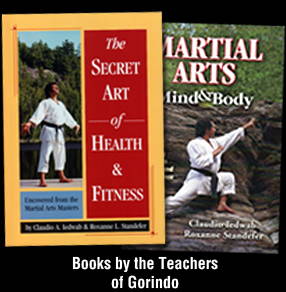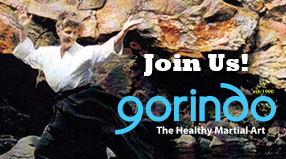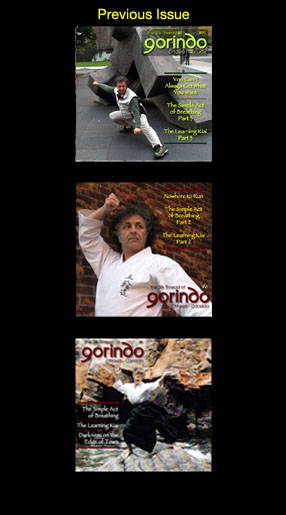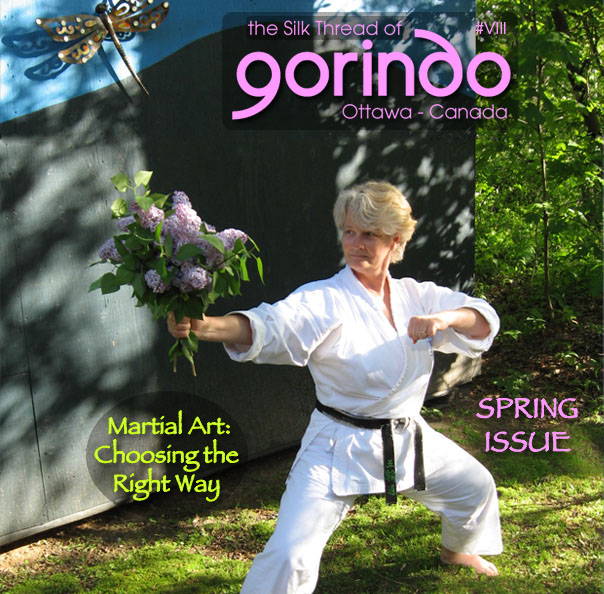
The Silk Thread of Gorindo - Ottawa - Canada
Issue VIII
- Martial Arts: Choosing the Right Way
- The Simple Act of Breathing (Part 4)
Photo cover Roxanne Standefer sensei at the Gorindo Dojo, Ottawa, May 2011, by Claudio Iedwab
The Learning Kiai (Part 4)
< read Part 3 (previous issue)
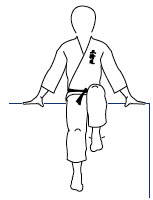
Learning for the Right Reasons
There are many stories associated with the history and traditions of the martial arts. Some have become legends, and are strongly influenced by the philosophy of Zen, which utilizes fables and questioning koan (Zen riddles designed to bring a student past intellectualization to intuition) to illustrate, educate and sometimes frustrate those who wish to follow its teachings.
One of the common traditions is the rejection of the beginner who presents himself at the gate of the temple, eager to learn all that he can, and all of it NOW. This tradition of turning away is much less common in the modern martial arts, (replaced by a more welcoming professional courtesy and perhaps influenced by a business requirement to pay the rent). Nevertheless the school still has a responsibility to try and ensure that the prospective student wishes to learn for the right reasons. The teacher must protect his current students from those who refuse to play by the rules, and also help protect society from bullies and psychopaths who should not be equipped with skills that could be misused and cause harm. Although the principle focus of training is the health and fitness of mind and body, the practical application of the martial arts must be taken very seriously. It is an important reason for the tradition of the direct transmission of knowledge from teacher to student, and also for some of the secrecy and double meaning associated with its history.
When oh When
Another popular story is the one about the new student who asks his teacher how long it will take to become a master. In modern times the question is usually phrased as: “When do I get my Black Belt?” The answer, usually accompanied with a shrug is: “It depends, maybe three to five years if you work very hard.” The eager pupil, keen to show his commitment will reply: “But I’ll work twice as hard as anybody, you’ll see! How long will it take me then?” The teacher, nonplussed, answers: “In that case, 6 to 10 years, I expect.” The student, confused by this answer exclaims: “No, no, you don’t understand. That’s far too long. I intend to train and train /fight /win, and I won’t think or do anything else but martial arts until I achieve mastery. Ok? How long then?” The teacher sighs and (having heard it all before) quietly states: “Twenty years then, or in your case, maybe never!”
A better question is: “How long do you train in martial arts?” The true answer is: “Until you die”. This illustrates that the study of martial arts is about so much more than acquiring a new skill, or another accomplishment for the athlete to check off his list or hang on his wall. The study of a Do is a way of life, and if pursued with energy and discipline, will offer rewards and experiences far beyond the simple pleasures of trophies and record times. This doesn’t mean that everyone who begins training will continue forever, or that someone shouldn’t even begin a martial arts class unless they are prepared to make that commitment. It merely points out that if you can get on the path, find a good teacher and apply yourself, you will discover a great deal more than you thought existed.
Gichin Funakoshi, considered the father of modern karate-do, remarked just before his death at the age of 89, that his only regret about nearing the end of his life was that he wished he had more time, because he was just beginning to grasp the true nature of the simple tsuki, or forward punch; one of the first techniques taught to the beginner. Such was the nature of his reflection upon the physical, from someone who can be truly named a master of the martial arts. For those who need to know the answer quickly, it seems that the results of the training will take too long. For those who come to understand that the answer is not the object of the search, (but instead it is the pursuit of the question) the results are instantaneous and long lasting.
When somebody wants something very badly, perseverance and commitment will usually dissolve the barriers of difficulty and expand the limits to achievement. Sometimes though, trying too hard or forcing one’s way can interfere with true progress. Unfortunately, in the mind of the “unaccepted” candidate, who gave up in frustration or was unable to challenge his entrance with sincere action from the heart, the manifestation of the clinical eye and experience of the teacher will never be very clear. The teacher normally doesn’t wish to make things difficult, or waste his time nor the time and effort of the prospective or probationary student. On the contrary, the teacher is ensuring that both will not waste them in the future. There is a lifetime of learning available in the martial arts, and centuries of knowledge to explore.
This is not a casual pastime
Of course, beginners don’t know this yet and fortunately, in a good martial art school, no one expects them to. White belt beginners are in a very privileged position within the system. They don’t have responsibilities other than to show up for class, be respectful, open their eyes, ears and mind, and try what the teacher suggests to them. It is definitely okay for a white belt to make mistakes or to not know what to do. A beginner who is pretending to be anything more than a beginner is generally frowned upon by others in a class. The senior students won’t waste much time helping show the way to someone who is not sincere in their desire to learn.
Overcoming Fear and Frustration
Recognizing and cultivating the Learning Kiai is not only a goal for beginners, it is an ongoing part of the program for every student. It is mostly a function of attitude and patience, and in that sense could be thought of as merely a process of the mind. However, because the learning is rooted so profoundly in the physical, the development of Learning Kiai reveals itself in all aspects of technique, fitness and endurance. Stiffness in the body often reflects rigidity of mind, for example, and until the student learns to let go a little and relax with his own abilities, progress might be very slow.
Beginners come to the training with many fears and they are mostly about their own capacity to perform and respond. There are many unknowns about how one begins and how classes are conducted. They need to be assured that nobody is out to hurt them, that they will not be challenged to fight the black belts, and they do not have to do their senior’s laundry, (all common misconceptions). The beginner still finds it difficult to believe and accept that their best effort will be sufficient and that no one is laughing at them.
Trust in the teacher and a friendly cooperative attitude everywhere in the dojo is very important in making the newcomer welcome, but it is just as important for students at any level. Difficulties and frustrations occur at many plateaus along the path. If a method for accepting and overcoming these challenges is not recognized as a technique to be learned alongside the skills of blocking, kicking and redirecting an attack; then it is not martial Art that is being studied, but merely fighting. It is of little use outside the arena of confrontation and therefore is of little use at all.
Excerpt from “Martial Arts Mind & Body” by Claudio Iedwab & Roxanne Standefer. See also their e-books available at askSensei.com >>
Illustration by © Claudio Iedwab
- Martial Arts: Choosing the Right Way
- The Simple Act of Breathing (Part 4)
« Click the Subscribe link on the left

